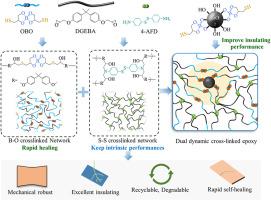双动态交联环氧树脂具有可修复性、可回收性和优异的绝缘性能
IF 9.8
1区 材料科学
Q1 MATERIALS SCIENCE, COMPOSITES
引用次数: 0
摘要
可逆键被用于制造具有自愈能力的绝缘聚合物,但它们的低键能导致机械、热和介电性能降低。本研究将四面体硼酯交联剂和4,4′-二氨基二苯二硫(4- afd)两种具有互补特性的可逆交联剂掺入环氧树脂中,以解决环氧树脂的自愈性和内在性能问题。具有高动态交换率的四面体硼酯交联剂促进了快速愈合过程,而具有较高交联密度和掺入纳米填料的4-AFD确保了优异的机械强度和绝缘性能。所得环氧树脂的断裂强度约为50.4 MPa,杨氏模量约为6.7 GPa,击穿强度高于常用的酸酐固化环氧树脂。在105℃温和加热10 h的条件下,具有物理和电树损伤的动态交联环氧树脂可以愈合并恢复其原有的绝缘性能,老化愈合过程后的击穿强度恢复效率为90.2%。此外,该材料可以在乙二醇溶液中降解和回收。为设计具有可修复性、可回收性和优良绝缘性能的环氧树脂提供了参考方法。本文章由计算机程序翻译,如有差异,请以英文原文为准。

Dual dynamic crosslinked epoxy exhibiting repairability, recyclability and excellent insulation performance
Reversible bonds were incorporated to create insulating polymers with self-healing ability, but their low bond energy leads to reduced mechanical, thermal, and dielectric performance. In this study, two types of reversible crosslinkers with complementary characteristics, namely tetrahedral boronic ester crosslinker and 4,4′-diaminodiphenyl disulfide (4-AFD) are incorporated into epoxy resin to address the self-healing and intrinsic performance issues. The tetrahedral boronic ester crosslinker with high rate of dynamic exchange facilitates the rapid healing process, while the 4-AFD with higher crosslinking density and incorporated nanofillers ensure the outstanding mechanical strength and insulating properties. The resultant epoxy exhibits a breaking strength of ≈50.4 MPa, Young's modulus of ≈6.7 GPa, and breakdown strength higher than commonly used anhydride-cured counterparts. The dynamically crosslinked epoxy with physical and electrical-trees damages can be healed and to restore their original insulating properties under mild conditions of heating at 105 °C for 10 h. The breakdown strength exhibited a recovery efficiency of 90.2 % after aging–healing process. Moreover, the material can be degraded and recycled in ethylene glycol solution. This work provides a reference method for designing epoxy with repairability, recyclability and excellent insulating performances.
求助全文
通过发布文献求助,成功后即可免费获取论文全文。
去求助
来源期刊

Composites Science and Technology
工程技术-材料科学:复合
CiteScore
16.20
自引率
9.90%
发文量
611
审稿时长
33 days
期刊介绍:
Composites Science and Technology publishes refereed original articles on the fundamental and applied science of engineering composites. The focus of this journal is on polymeric matrix composites with reinforcements/fillers ranging from nano- to macro-scale. CSTE encourages manuscripts reporting unique, innovative contributions to the physics, chemistry, materials science and applied mechanics aspects of advanced composites.
Besides traditional fiber reinforced composites, novel composites with significant potential for engineering applications are encouraged.
 求助内容:
求助内容: 应助结果提醒方式:
应助结果提醒方式:


